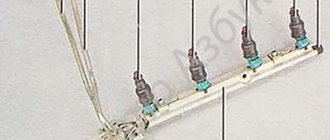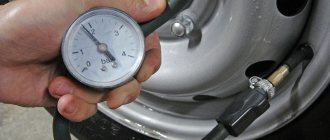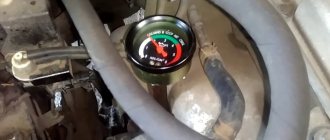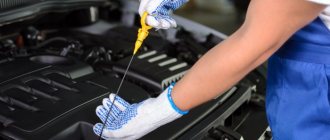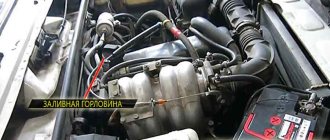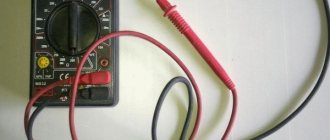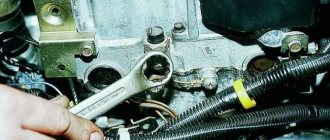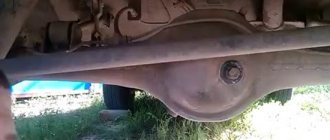Oil pressure on a VAZ-2112: how much should it be?
Many motorists know that the 16-valve VAZ 2112 engine has engine compression. This is an indicator of oil pressure, which is found in all modern engines. But, for a given engine, what should this indicator be? This is exactly what this article will discuss. Video about checking compression and oil pressure in the engine:
The video material will tell you how to correctly measure the oil pressure in the engine.
What is oil used for?
The oil pressure indicator lights up on the instrument panel
Automotive oil plays many functions in a car. Initially, this is the lubrication of parts and internal elements. So, without this, rapid wear of most spare parts is inevitable. The second function is cooling the motor elements. Oil is a good “heat absorber”, which provides additional protection against overheating.
The third function is to provide compression. This indicator gives traction power and normal functioning of the engine, namely operation at idle and at higher speeds.
What builds up oil pressure
To pump oil, the engine has an oil pump, which lifts oil from the sump and distributes it throughout the entire system. Thus, it not only provides lubricant, but also creates the necessary pressure. There are several factors that can cause the pressure in a car to drop:
- Unstable timing.
- Oil pump failure.
- Valves not fully closed.
- Other factors that can lead to loss of engine pressure.
What should the pressure be?
Now, directly to the question, what should be the pressure in the 16-valve VAZ 2112 engine? If you believe the manufacturer’s data, then the engine when measuring the pressure gauge should produce the following indicators:
- At idle speed - 2-2.2 bar.
- At speeds of 4-5 thousand - 5-6.5 bar.
The pressure gauge measures the oil pressure in the engine
As practice shows, most motorists have the following indications:
- At idle speed - 1.5-2 bar.
- At speeds of 4-5 thousand - 4-6 bar.
This indicator is considered normal for the complete and uninterrupted functioning of the engine, as well as ensuring the normal operation of all systems.
When measuring a 16-valve VAZ 2112 engine, the pressure gauge shows the following indicators: idle speed - 1.8 bar; speed 4-5 thousand - 5 bar. This is quite enough for the systems to function normally and for no interruptions in engine operation.
Another factor is winter.
The season of operation of the car can also affect the lubrication system. In winter, in severe frosts, the oil can harden so much that the first time after starting the engine the pump is not able to pump it in the required quantity. Preheating the pan before starting the engine can eliminate this problem.
Another reason for the pressure lamp to light up after starting the engine in winter is condensation. Due to temperature changes, moisture accumulates inside the engine, which then settles and freezes on internal surfaces, including the oil intake screen and oil channels. In this case, letting the car sit in a heated place will help - after the engine heats up, the condensate will melt and drain into the pan.
Note that the above describes the general causes of a drop in engine oil pressure, which are typical for any car - VAZ-2109, 2101, Priora, Niva, 2110, 2114, etc.
Lada 2112 Melt water, 206 metallic › Logbook › The oil pressure lamp is blinking 21124
Hi all! I’ll tell you my story of struggling with the 16-valve engine 21124. Last summer I began to notice that under load or during sharp acceleration the compensators began to knock, but in other operating modes they were not audible (at idle, after the first start, etc.) . In my naivety, I decided that it was the compensators that were faulty, so I bought a set of new ones. When checking old compensators, I found 4 faulty ones - the ball-shaped valve had already broken the seat and did not hold pressure. In general, I installed a new kit, BUT since I couldn’t find the anaerobic sealant Loctite in my city (and out of my stupidity), I put the camshaft bed on SILICONE SEALANT (applied it in a thin layer so that it would not crawl into the oil channels when tightened)
Everything seems to be ok, I start the engine - under load the expansion joints still make the same noise! In addition, the oil pressure light started blinking! NEVER USE SILICONE SEALANT IN AN ASSEMBLY, it gives additional thickness (later I read in a book that both the camshaft bed and the cover should sit exclusively on anaerobic sealant) Since the camshafts did not knock, I did not even pay attention to the level of wear on the journals during assembly (And now, six months later (while there were frosts I didn’t undertake repairs), preparing for the worst consequences, I’m already starting to save money for a new cylinder head (about 30,000 rubles), I decided to check the shafts for wear, and in general it’s worth catching something from the old cylinder head. When removing the shafts by eye, a decent amount of wear was visible on the last journals (from the thermostat side)
23.93 mm. I bought new standard shafts, size
23.97 (reserve for bed wear), found anaerobic sealant in syringes (took 2 pieces with a reserve), at the same time for carrying out drips. repairing the cylinder head, in order not to climb into it 10 times, I bought additional oil. caps, lapping paste, new studs, plugs, etc.
Source
Reasons why there is no compression in the cylinder
Poor (small) compression in one or all cylinders indicates engine wear. There is an old and simple way to determine why compression has disappeared. You need to pour a tablespoon of engine oil into the spark plug hole and repeat the measurements:
- if the pressure has increased noticeably, it means the piston rings have poor sealing;
- if the pressure has not changed, then there may be several reasons (for example, leaking valves, broken gaskets under the cylinder head, there is a crack or burnout in the walls of the combustion chamber, in the piston bottom).
There is another, more accurate way to find out why compression has disappeared. To do this, you will need to modify the spark plug. We remove the insulator from it, and weld the valve of the car camera to the metal body. Next, set the cylinder piston to the ignition timing position, remove the radiator caps and oil filler neck, screw in the manufactured adapter and pump air into the cylinder using a pump (create pressure in it):
- if air enters the exhaust pipe, it means the exhaust valve is poorly sealed;
- If air goes into the intake manifold, there is a problem with the intake valve.
- if bubbles appear in the expansion tank, then check the cylinder head gasket;
- If there is a hissing sound in the oil filler neck, it means that the piston rings are not properly sealed.
Engine diagnostics using compression measurements in the cylinders allows you to quickly and accurately determine its condition without disassembling, and in some cases will help avoid major repairs of the power unit. Have you ever experienced a lack of pressure in the cylinders? What was the cause of the malfunction? If engine problems persist, check the fuel rail pressure.
Source
When the engine is hot, the oil pressure of the VAZ 2112 lights up
- Registration
- Entrance
- To the beginning of the forum
- Forum Rules
- Old design
- FAQ
- Search
- Users
How long can you drive with a clogged net?
First, check the oil level.
When the mesh got clogged, the hydraulics were knocking, but the light practically didn’t blink!
I’ll probably change the filter first, or as it’s cleverly called: “oil receiver.”
But I don’t have any knocking noises, but when it heats up to 90 and above, it starts blinking when idling.
Change the sensor first. The most inexpensive event. The same nonsense happened, when it warmed up it started to blink, especially if you were in a traffic jam or moving slowly.
And it saved? How much does the sensor cost?
The problem was precisely with the sensor. The sensor cost about 200-300 rubles.
Change the sensor first.
+1 Bagbeer
-)) What did I say?
and where is the oil pickup grid at 16v?
Information on icons and features
You can not
start topicsYou
cannot
reply to messagesYou
cannot
edit your messagesYou
cannot
delete your messagesYou
cannot
vote in pollsYou
can
attach filesYou
can
download files
Source
What are the cylinder compression standards for VAZ engines?
Engine specifications must indicate “minimum cylinder compression values.” If you cannot find such data, determine the compression standards yourself using the formula:
| Compression (kgf/cm2) = compression ratio (see technical specifications of internal combustion engine) * coefficient (for VAZ min 1.2, max 1.3) |
- The compression ratio of modern VAZ 21126 and VAZ 21127 engines installed on Granta, Kalina and Priora is 11. We multiply the values using the formula and get the compression standards: 13.2..14.3.
- For the Vesta engine (VAZ-21129) the compression ratio is 10.45, the compression standards will be: 12.5..13.6.
- For Niva (VAZ 21213, 21314) - 11.3..12.2.
If the compression gauge values in all cylinders are within the normal range, this does not mean that everything is fine. Different compression in the cylinders is also bad
It is important that the difference between all readings is minimal. Compare the minimum and maximum compression values in the cylinders
According to technical standards, the difference should be no more than 1 kgf/cm2 or 10%.
How to Diagnose and Fix Engine Pressure Problems
Two problems can occur in the engine lubrication system. The pressure can deviate in two directions:
Signs and remedies for low engine pressure
The first rule: if while driving the engine pressure sensor light (watering can on the dashboard) comes on, you should stop immediately. Driving a car whose engine is starved of oil is simply dangerous. If the engine seizes, an accident may occur, for which the owner of the faulty vehicle is found to be at fault.
What to do if the engine oil pressure light comes on on the instrument panel:
- stop if the car is moving,
- Check the oil level after 5 - 10 minutes, when the oil has drained into the crankcase.
When the level is below the minimum level, the pump cannot capture enough oil. Add engine oil using the dipstick as a guide. Often this is enough for operating parameters to return to normal values.
Ingress of foreign substances
If the oil level, on the contrary, has increased, antifreeze or fuel has probably gotten into it. Check to see if the volume of the antifreeze has decreased and if you can smell fuel from the oil filler neck. If such signs are found, these systems will have to be repaired.
Problems with pressure reducing valve
If the oil level is fine, the causes of engine pressure problems should be looked for elsewhere. For example, due to contamination, the pressure relief valve is stuck in the open position or the oil receiver screen is clogged. To deal with this problem, it is necessary to use a special flush.
Unsuitable type of engine oil
Another reason for low engine pressure is insufficient viscosity of the engine oil at operating temperatures. In this case, the indicator on the dashboard begins to blink when the engine speed decreases to XX when the engine is warm. Make sure the crankcase contains the recommended grade of oil. There may have been an error during the last replacement.
Even suitable motor oil can lose its properties due to overheating or other unfavorable factors. This problem is “treated” by changing the engine oil. A temporary solution is to use a special viscosity stabilizer.
Malfunctions of the filter unit
If the engine oil pressure light comes on after starting the engine and does not go off for 10 seconds or a little longer, the problem is usually in the oil filter. Check and replace this element if necessary.
How to determine the malfunction?
The oil light on the instrument panel came on. This is a bad sign!
Usually the light on the instrument panel will light up first if there is something wrong with the pressure. As long as it doesn’t burn, the pressure is most likely normal. If the pressure is not all right, the engine noise will increase. The earbuds will also start to knock. This will be clearly audible when the engine speed exceeds 3,000.
Consequences
If the liners rattle, then you will need to disassemble the engine and grind the crankshaft. But sometimes sanding may not be necessary. All parts of the cylinder head are most susceptible to damage. In this case, the motor will stall. Then the camshaft will begin to collapse.
When oil starvation occurs in the engine, it will take less than a minute of engine operation for the liners to turn into foil. This should be remembered.
How to check the serviceability of a part
After starting the internal combustion engine, the oil pump pumps fluid to all engine systems. From the crankcase through the filter, oil is supplied to each part, and the pressure gradually rises to operating condition. The light on the instrument panel lights up when there is insufficient pressure in the system. If the indicator does not go out longer than usual, then it is worth checking whether the sensor is working properly.
But a long-burning light can also indicate problems with low pressure due to other parts:
- The oil filter is clogged with dirt. The liquid entering the system is insufficient. The pump cannot create the required pressure. In this case, it is worth cleaning the filter and replacing it with a new one.
- Carbon deposits, which are washed away by oil from inside the engine, can also accumulate on the oil pan, clogging the oil receiver mesh and reducing its permeability. It is better to drain the lubricating fluid from the crankcase. If contamination is severe, replace with new oil.
- Oil pump malfunction.
- High wear of engine parts, in particular the crankshaft.
- Poor quality oil is poured - it is worth buying proven brands recommended by the car manufacturer (semi-synthetic 10W-40, volume - 3.5 l).
- Insufficient fluid level in the system - checked when the engine is cold with a dipstick, solved by adding oil.
If these reasons are considered, and the lamp on the panel is on, then the problem is a malfunction of the DADM (emergency oil pressure sensor) or the wiring from the device to the indicator. To check the device, you need to know where the faulty oil pressure sensor is located on the VAZ 2114. The part is located under the decorative cover of the internal combustion engine (internal combustion engine) on the left side of the engine compartment. The device is installed near the timing belt (gas distribution mechanism), on the right in the cylinder head (cylinder head), below the valve cover.
To professionally check the performance of the emergency oil pressure sensor, it is recommended to take the car to a specialized service station. But this is not always possible. Therefore, you need to know how to check the oil pressure sensor yourself. There are several options here:
- Visual inspection of the part - smudges in the place where the device is fixed may indicate a problem with the sealing washer. It is necessary to replace the ring and wipe the installation site. The fastener also leaks in the event of a malfunction of the excess pressure relief valve in the oil pump (the pressure in the system is above 0.8 atmospheres). If signs of a leak are found at the terminal attachment point, this clearly indicates the need to replace the sensor itself.
- The sensor is unscrewed and a pressure gauge is installed in its place. It is necessary to start the car engine and monitor the readings at idle speed. At normal oil pressure in the system, the parameter will be within 0.65 atmospheres. This indicates a faulty part.
- Without starting the internal combustion engine, with the sensor removed, it is necessary to crank the starter. Splashes from the device mounting hole indicate the presence of pressure in the system. But in this way it is impossible to find out its parameters.
- A new sensor is installed in place of the old device. If it works correctly, then the old device is faulty.
The oil pressure sensor on the VAZ 2114 cannot be repaired. But the low cost of the part will allow you to simply replace it with a new product.
In any case, if the pressure in the oil system is low or completely absent, it is not recommended to drive the car any further. This could lead to a serious problem with the engine.
What pressure should be in the system?
The sensor serves only to determine the pressure drop, but it does not indicate the exact indicator of this parameter. Therefore, a conventional 10 bar dial pressure gauge is used for measurement.
For measurements, you can use any device, adapting it to the engine or using a pressure gauge specially designed for this.
To use a conventional pressure gauge, you will have to improve it a little so that it can be connected to the motor. To do this, you will need the pressure gauge itself, a piece of thick-walled rubber tube, clamps and a threaded fitting for the hole for installing the pressure sensor.
We connect all this into one structure, and securely clamp the joints of the tube with the pressure gauge and fitting with clamps.
With a special pressure gauge for measuring oil pressure on engines, such a procedure is not required, since it is already equipped with a fitting and adapters for connecting to the engine.
Measurement is performed using the following technology:
- Disconnect the wire and unscrew the pressure sensor;
- We screw the pressure gauge into the sensor seat and tighten it well (but do not overdo it, since the thread in the hole is aluminum and breaks easily);
- We briefly start the engine (a short period of engine operation will not cause any damage);
- We look at the device readings.
Engine oil pressure. Which should it be? We will also analyze the 16 valve engine from the VAZ 2112
Nowadays, fewer and fewer cars are equipped with an engine oil pressure sensor, if you look at budget foreign cars - I don’t even remember which ones have it. However, now there are enough cars of previous generations on the market, but they had such a sensor. For example, on some VAZ, UAZ, VOLGA, etc. Many people ask the question - what oil pressure should be in the engine, that is, what is the normal value and what is not? It is not always possible to find information specifically about your model, so this article will be useful to everyone...
You know, now manufacturers are simplifying the dashboard of cars more and more, for example, on mine (Chevrolet Aveo T300) there is no longer even an engine temperature sensor, I’m already silent about the oil pressure sensor. It turns out that the manufacturers want YOU to ruin your iron horse faster, because you cannot control all the necessary parameters, and accordingly, if you operate it incorrectly, you will quickly come running to them to repair it. All this can be attributed to a conspiracy by the manufacturers. Although now they say everywhere that cars have become more reliable, different materials are used, etc., but practice shows the opposite, three to five years and it’s better to change the car. Oh, there were times - there were cars, there was complete control over the engine.
Why do you need oil at all?
I often hear that oil is the lifeblood of the engine. This is not entirely true, of course, the comparison is very rough, but still, the engine will not function without oil (or it will, but not for a very long time).
Modern motor oils lubricate and protect all rubbing parts, and these are pistons (with their rings), shafts, bearings, etc. Let's just say that good oil extends the life of the engine by many thousands of kilometers.
BUT oil must flow through the system, just like blood itself through human vessels, if the oil is simply poured in a pan and does not go to the rubbing parts - IT IS USELESS!
What builds up oil pressure in the system?
Everything is simple here - there is a special oil pump that takes oil from the engine sump and pumps it through the system. It is usually installed in the engine sump and driven by special gears that the engine turns during operation.
Oil through many channels begins to be supplied to the right places under pressure, as I already wrote, this is the crankshaft and its bearings, the camshaft and its “bed”, pistons, and much more.
It is the pump that is responsible for the pressure; if the pump stops, the pressure indicator will drop to zero. THIS CANNOT BE ALLOWED! Because the engine will not be lubricated at all, which will lead to instant breakdown, especially at high speeds.
BUT often the oil pump does not stop, but simply begins to pump worse, this indicates its wear, which is why you need to know the oil pressure in the engine! To respond in time to the nearest oil pump failure.
Alarm indication
Of course, now in almost all cars there is an emergency indication for a complete lack of pressure, this is known to us all - a “burning oil can”. If it does not go out for some time after starting, for example 10 - 20 seconds is one thing, it is almost always the fault of the oil filter. But if the lamp is constantly on, then this is already an alarm bell. Perhaps the oil pressure sensor has simply failed, or perhaps the oil pump has failed.
In any case, the emergency indication is very important, and I do not advise you to joke with it; nevertheless, this is fraught with a major overhaul of the engine.
Remember this rule, if the lamp comes on, then turn off the car and preferably immediately to a service station, either a tow truck, or in tow.
How to check oil pressure?
The actual check is carried out using a special device - a pressure gauge. It is also worth noting that you need to warm up the engine to operating temperature, usually 90 degrees Celsius.
If you measure with a cold engine, especially in winter, the pressure can jump to high values, from 0.5 BAR or even higher, but measuring with a cold engine is WRONG!
In order to check the pressure, you need to find the emergency sensor, which is responsible for the indication on the dashboard. It is worth noting that it is not always located nearby and it is convenient to unscrew it. We unscrew it, and in its place we attach the test output connected to the pressure gauge.
VAZ 2112: engine compression - check and increase
VAZ 2112 engine compression, measuring pressure in engine cylinders
Compression in a VAZ 2112 engine is the most important indicator for diagnosing engine faults without disassembling. Engine compression is the pressure in its cylinders that is created at the very end of the compression stroke. When there is insufficient compression in the VAZ 21124 engine, the engine power is noticeably reduced. The difference in pressure values in each cylinder, and its average value, make it possible to determine quite accurately the level of general wear of the engine piston group, and to identify malfunctions in the piston system and in the system of valve mechanism parts.
Oil pump VAZ 2112
Engine oil pump, a device necessary for injecting oil from a running engine, which is under pressure to the moving surfaces of the engine mechanisms. It is designed to increase the pressure in the internal system of the engine, and is thus used to provide lubrication to all operating parts of the internal combustion engine.
Malfunctions
Most often, the pump of the VAZ 2112 and other VAZ models with front-wheel drive leaks through the seal, which has to be changed.
The oil receiver also often fails, especially if you use low-quality oil, or missed replacing it in a timely manner, or the oil does not meet specifications (too thick).
Too liquid simply will not be pumped and the pressure sensor will immediately light up.
In this case, the oil receiver mesh becomes clogged, the circulation of oil through the engine becomes difficult, causes oil starvation, and as a result, the service life of the engine is significantly reduced.
This includes a malfunction of the pressure reducing (bypass) valve: either it is stuck in the open position, and then the oil pressure drops. Either it does not bypass, and then the oil will squeeze out through the oil seal
Replacement
The order of dismantling work:
First of all, it is necessary to drain the oil from the engine crankcase;
After all the oil has drained onto the pan, you need to remove this very pan;
Remove the oil sump;
Then you need to unscrew the oil receiver mounting bolts;
Now you can remove the oil receiver itself;
Remove the sealing gasket of the oil receiver;
Remove the camshaft drive belt;
Remove the crankshaft pulley;
Unscrew the bolts and remove the oil pump together with the sealing gasket;
First you need to thoroughly clean the oil receiver mesh from dirt, and then rinse it with white spirit. If the mesh cannot be cleaned or damage is visible on it, then it is necessary to replace the oil receiver itself. Our industrial portal provides the opportunity to all registered customers to purchase or order any vehicle part from a special catalog from manufacturers;
The new device is installed on a VAZ 2114 car in directly proportional order from removal. And before installing it, do not forget to replace the old sealing gaskets with new ones.
After you have replaced the VAZ 2114 oil pump, you need to fill in new oil.
A very important point when working to troubleshoot a car's oil pump is the tightening torque. In particular, if you tighten the pan, the tightening torque of which is only 0.5-0.8 kg, then the gasket will come out. As a result, oil will leak. Do not allow the gasket to be squeezed out from under the pan. Therefore, for a VAZ 2114 car, the tightening torque of the oil receiver mounting bolts is 10 N•m, and the tightening torque of the mounting bolts of the unit itself is 12 N•m.
If a red indicator lights up on your instrument panel, signaling a lack of oil pressure in the system, then do not rush to run to the store and buy a new oil pump.
The video discusses the most basic reasons why oil pressure may drop in a VAZ engine:
Compression check
- Today there are already compression gauges with a threaded fitting to screw them in instead of spark plugs
- In addition, there are compression meters that have rubber tips instead of a threaded fitting.
- A compression gauge with this design is simply pressed firmly against the hole when checking compression
- In order for the compression meter readings to be as accurate as possible, you simply need a working starter, electrical circuits, and a fully charged battery
- Start the engine and warm it up, the test temperature is 80-90 degrees
- Relieving pressure in the fuel supply system
- Then remove the fuel pump fuse to de-energize the fuel pump.
- Remove the wires from the ignition coil and turn out all the spark plugs
- We screw the compression gauge (or press it if the device is of a clamping type, as in the photo below) into the spark plug hole of the cylinder being tested
We insert the compression gauge into the hole from the spark plug, while an assistant turns the engine with the starter
- If you have a pressure gauge, then you will need an assistant
- Let him press the accelerator pedal all the way so that the throttle valve opens fully (maximum) (while you hold the compression gauge)
- Then, without releasing the pedal, let him turn on the starter and turn the engine crankshaft with it until the pressure inside the cylinder stops increasing
- Which roughly corresponds to four compression cycles
- Indeed, in order to obtain the correct readings of the compression meter, the crankshaft must certainly rotate at a speed that has limits not lower than 180-350 rpm
- Record the compression gauge readings, then set the arrow to zero.
- To reset the readings, you need to press the air release valve
- Compressometers have different devices and readings are also reset in different ways.
- Then we repeat the operations written above for all remaining cylinders
- The pressure in the cylinders should not be lower than 1.0 MegaPascal and the difference in readings in the cylinders should not be more than 0.1 MegaPascal
- Reduced compression of the VAZ 21124 engine in some cylinders may occur due to a loose fit (loose fit) of its valves in the seats, due to damage to the gasket under the cylinder head, as well as breakage or burning (sticking) of the piston rings
- When reduced compression is detected in all cylinders without exception, it turns out that wear (breakage) of the piston rings has occurred
- To correctly determine the cause of insufficient compression, it is recommended to fill each cylinder with low compression with 20cc (cubic centimeters - use a medical disposable syringe) of clean oil (motor oil) and measure the compression again
- When the compression gauge readings increase, it means that the piston rings are most likely damaged.
- And when the compression value has not changed at all, this means that the valve plates do not fit well to the seats, or the gasket under the cylinder head is damaged
- Or the most unpleasant option is that the piston burns out, with the modern quality of fuel and spare parts this is not surprising, I happened to be an eyewitness to a similar phenomenon
The principle of operation of the warning lamp on the VAZ 2110
The warning lamp for emergency oil pressure in VAZ 2110 cars is located in the lower left corner of the instrument panel. It is easily identified by its characteristic icon in the shape of an oil can.
The oil pressure warning lamp is located in the lower left corner of the panel
The light works in tandem with an emergency pressure sensor, which is installed in the cylinder head and connected to the oil line. These two elements are combined into a simple electrical circuit similar to a test “pilot lamp”, where the sensor acts as a switch. The design of the sensor is also very simple. It consists of a housing with a fitting and a membrane with a contact connected to the on-board network of the machine.
Design and connection diagram of the emergency pressure sensor
When the engine is turned off, there is no pressure in the lubrication system and the membrane is in a free position. The contact is closed to sensor ground. When we turn on the ignition, but do not start the engine, everything remains the same, only power is supplied to the contact. Since the circuit is closed, our control lamp is on. As soon as we start the engine, the pressure in the system begins to rise and act on the sensor membrane, moving it away. The contacts open and the lamp goes out. But this only happens when everything is working properly.
What you need to know about DDM?
Before diagnosing and replacing the oil pressure sensor, you need to know where the oil pressure sensor is located. First, let's briefly talk about the purpose and installation location of the device.
Purpose and location
The VAZ 2110 oil pressure sensor is a device used to notify the car owner about the low level of consumable pressure in the engine. Thanks to this controller, the owner of the “ten” can promptly determine the cause of the malfunction, as well as avoid possible problems that may occur as a result of “dry” operation of the power unit. But it should be borne in mind that if the oil light on the dashboard suddenly lights up on a VAZ 2110, there is a possibility that the problem lies in the regulator itself.
We recommend: Oils for Nissan
To check the device, you must first find it - the device can be located in two places, depending on the design features of the motor:
- On an 8-valve engine, the device is located on the rear of the power unit, on the right in the cylinder head connector, not far from the belt guard. One wire is connected to the DDM.
- As for engines with 16 valves, in this case the DDM should also be looked for on the rear of the internal combustion engine, only on the left, directly on the camshaft block. One wire is also connected to this controller, however, next to it there are two more bundles with wiring (the author of the video is the Auto_Remont channel).
Diagnostic features
If you notice that the emergency engine fluid pressure indicator on the dashboard is constantly on, then you should diagnose the regulator. It would be a good idea to check the wiring as well. Diagnostics of the device begins with checking the electrical circuit in the area directly from the DDM to the indicator on the device.
Diagnostics is carried out as follows:
- First, on an 8- or 16-valve engine, disconnect the wire and connect it to ground, in particular, the body or engine.
- If, after connecting the wire, the indicator on the device starts to light up, this indicates that this section of the electrical circuit is working properly, so you can start diagnosing the regulator. Dismantle it and carefully inspect the device - if it is dry and operational, then the reason for the lit indicator most likely lies elsewhere. For example, this could be a filter or oil pump. But if the controller itself is wet, in motor fluid, then this indicates that it should be changed.
If your oil pressure light comes on, first of all you need to check the oil level; in some cars the light comes on when the oil filter is clogged and the bypass valve in it has opened.
Replacement instructions
How to replace the VAZ 2110 oil pressure sensor:
- First you need to disconnect the power cord from the regulator.
- Using a 21mm wrench, you need to unscrew the DDM from its seat, and its steel seal is removed along with it.
- A new DDM is installed in place of the dismantled device; it is also necessary to replace the seal, which should be included in the kit.
- After the regulator is installed, it is necessary to clean the contacts on the connector, and also check the integrity of the dust seal. If everything is fine, then connect the power cable to the DDM and check its functionality.
Oil filter
A clogged and worn oil filter invariably leads to a decrease in oil pressure in the system. In a serviceable, correctly selected and installed filter, a certain amount of lubricant always remains after the engine is stopped. This is provided for by the design of the device. If the filter is worn out, or does not correspond to the engine modification, oil will flow from it into the crankcase, causing a “starvation” effect in the engine.
When the filter element becomes clogged, its throughput capacity decreases. In this case, the pump operates in normal mode, however, the amount of oil entering the system is reduced. Naturally, this leads to a drop in pressure. If you are unsure whether the installed filter matches the engine parameters, or the car with it has traveled more than 7 thousand km, replace it. A new filter unit for a VAZ 2110 will cost you about 200 rubles.
Important: it is advisable to replace the filter simultaneously with changing the lubricant. When installing a new filter, be sure to fill the housing with fresh oil. This will prevent the appearance of air locks in the system and protect the engine from oil starvation.
When replacing the oil filter, be sure to fill the filter housing with fresh oil.
Solution methods
In order to eliminate an engine malfunction, you will need a set of tools, as well as knowledge of the structure of a car engine. So, let's look at how to fix the problem.
Sensor and wiring
Before you start panicking, you need to turn to the most harmless solution - a sensor. If it fails, the contacts close, so the lamp on the instrument panel can remain on constantly. To solve the problem, it is necessary to dismantle the sensor itself and check it, replacing it if necessary.
Removing the oil pressure sensor wire connector If replacing the sensor did not yield anything, then you should check the wiring for insulation and continuity. Maybe a wire broke somewhere and that was causing the problem. Using a multimeter, it is worth diagnosing the wiring, which will take a few minutes. If a break is detected, in order not to go to extremes, it is necessary to clean the break site and solder the wiring, then insulate it from external factors. This can be done using a crimp tube or electrical tape.
Insufficient oil level
Insufficient oil level in the power unit can also cause the indicator to appear. This is due to the fact that with a small amount of lubricating fluid, the pressure in the engine itself also drops, and therefore the sensor transmits a signal to the ECU that the compression is not enough. To eliminate the malfunction, it is necessary to add oil to the engine until the level is between the maximum and minimum marks.
A dipstick that shows how much oil is in the engine.
Change of oil
Another reason why the oil pressure indicator on the dashboard starts to light is the production of lubricating fluid. Thus, the loss of physicochemical and technical qualities can cause the pressure to drop to a minimum and lead to a signal. The way to solve the problem is to simply replace the lubricant and, accordingly, the filter, which, most likely, is also not in the best condition.
The oil filler neck is unscrewed to fill the liquid.
Oil pump
More complex reasons and solutions for the appearance of an oil pressure indicator is the failure of the oil pump.
A pump malfunction makes it impossible for oil to circulate through the system, and therefore it is not possible to create the required pressure. So, its replacement will require disassembling and repairing half of the power unit, and therefore, as practice shows, motorists carry out major repairs of the internal combustion engine.
Oil pump removal diagram.
Block head and power unit
The last reason that can catastrophically affect the loss of pressure in the main power unit is the malfunction of this unit. Thus, small gaps in the gaskets and regular loss of oil reduce the pressure, which in turn leads to increased wear of the entire assembly. Another reason for the drop in pressure in the engine and the activation of the indicator can be the wear and tear of the connecting rod and piston group, crankshaft and camshaft, as well as oil seals.
Reasons for decreased pressure
If the warning light on the dashboard comes on, it means the oil pressure in the engine has lost. It is worth remembering that if the engine is not warmed up, it may not light up. If the indicator flashes at low speeds and goes out at high speeds, you need to stop using the car and start looking for the cause of the problem.
- First of all, check the top and bottom of the engine for leaks, make sure that there is enough oil fluid in the power unit. If the volume of lubricant is below normal, the oil pressure will drop and oil starvation will begin. It should be noted that if there are no leaks, but the engine was running at high speed for a long time before the indicator flashed, it means that the lubricant is being wasted.
- Check the condition of the vehicle oil. Do not use too thin or thick lubricant that is not suitable for your car. Most often, it is the use of too liquid a petroleum product that causes low oil pressure.
- If coolant penetrates into the lubricant complex, the pressure will drop. This is due to the following. When the lubricant is diluted with antifreeze, it foams. The oil pump captures the foam. As a result, the volume of motor oil in the power unit becomes lower. Antifreeze can enter the engine crankcase through a crack or through a damaged cylinder block gasket. The problem can be identified by thick white exhaust, emulsion on the lubricant filler plug or on the dipstick.
- The properties of the motor oil are significantly affected by the fuel in the crankcase. If there are any problems with the engine (flammable fuel, low pressure in the cylinder block), then gasoline/diesel enters the combustion chamber, but does not burn out. In this case, the fuel penetrates through the leaky piston rings into the crankcase and dilutes the oil. The viscosity of the lubricant will become lower and lower. If there is no burnout in the cylinder block, the engine runs rough, malfunctions, smokes, and wastes a lot of fuel.
- Why does the oil pressure in the engine still drop? The reason may be a fake or defective oil filter. If it does not have a special valve/washer, then after turning off the engine, the oil from the oil channels and filter element will end up in the crankcase. Each time the engine is turned on, the indicator will flash. Significant contamination of the oil filter can lead to the same effect. Replace the filter on time.
- Low oil pressure in the engine may be caused by a lubricant leak from under the indicator. It will flash when the motor is running.
- One should not exclude the possibility of problems with the lubricant complex. Malfunctions of the oil pump often lead to changes in normal compression. Although manufacturers provide a performance margin, at a certain point the gaps between the pump gears and the housing become too large.
- Problems with gasoline/diesel internal combustion engines are also considered to be the cause of low compression. Because of them, the oil cannot properly press on the parts when supplied. A worn crankshaft/camshaft and piston rings lead to a decrease in compression.
We recommend: Why does the idle speed fluctuate?
Oil pressure sensor VAZ 2114: device, principle of operation and replacement
If we consider the oil pressure sensor of the VAZ 2114, then it is worth noting that it is an important component in the car. The manufacturer says that the car must contain at least 3.5 liters of engine oil
In this case, it is necessary to monitor the quality and level of the oil, replacing it on time.
Such a sensor serves an important purpose; it is necessary to inform the driver about any existing malfunctions in the oil system. If there are any problems, this will be indicated by a light on the dashboard - emergency pressure light
When considering this issue, it is worth emphasizing that the liquid that is poured into the system is located in the crankcase. If necessary, its level can be checked using a dipstick, which has special lines. Usually it marks the maximum possible level and the minimum possible level.
It should be borne in mind that it is not always possible to carry out such measurements; the engine must be cold to carry out the check. The fact is that after startup, the liquid is distributed throughout the system under the influence of a special pump. It is supplied to the main line, passing through a filter; the essence of the work is to create the necessary pressure in the system.
Emergency measures
So, the oil pressure light on the dashboard came on while driving. As already noted, you should immediately stop and turn off the engine. Since while on the road there is no way to accurately determine the cause of the problem, the only diagnostic method is a visual inspection.
After stopping the engine:
- Carefully inspect the power plant for oil leaks - valve cover, pan, oil filter, end surfaces of the engine (near the auxiliary drive pulley and on the gearbox side);
- Check the condition of the circuit to the oil sensor, while monitoring (as far as possible) the integrity of the wire;
- During the time it takes for a visual inspection, the oil will drain into the pan, so we check its level with a dipstick.
Depending on the results of the inspection and level check, we take further actions. If a slight leak is detected, and the dipstick shows the amount of lubricant below o, you can continue moving to the repair site, but first replenish the oil loss and check whether the warning lamp lights up.
To top up, you should use the same lubricant that was filled in (it is not for nothing that it is recommended to always carry oil with you for topping up) or purchase a similar one. During the movement, you should stop periodically and replenish the level.
We do the same in the case when no leaks are detected, but the level is below normal. We just add lubricant, make sure that the control light does not light up and continue on our way, periodically stopping and checking the dipstick.
If there are no leaks and the oil level is normal, it is possible that the pressure sensor is acting up. Restarting the engine after a short pause (the time it will take to inspect the engine and assess the amount of lubricant) will help verify this.
If the lamp lights up even when you restart it, it is better not to experiment, but to call for help to transport the car to the repair site.
It is strictly forbidden to operate the machine if the dipstick shows a level higher than normal or if there is a foamy whitish coating on it - emulsion (you can additionally check for the presence of emulsion on the oil filler cap).
This indicates that other technical fluids, such as antifreeze or fuel, are leaking into the pan. An excessive level of oil (liquid mixture) in the pan has a strong negative effect, as does its lack.
The problem is diagnosed by the non-characteristic color of engine oil and smoke from the exhaust pipe.
These are all the measures that can be taken in an emergency situation - when the lamp lights up while driving and there is no necessary equipment and tools for a more detailed search for the cause.
